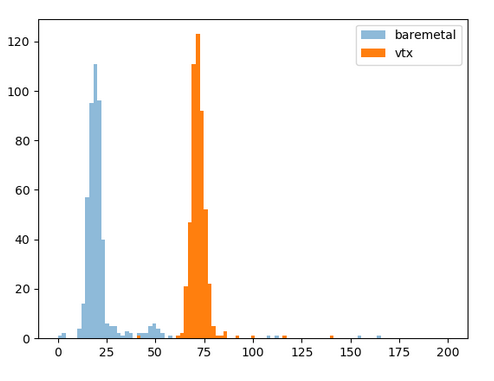Detecting Intel VT-x from TLB Miss Latency
2022-02-24 | Tags: #research # virtualizationI read a paper called "Detecting hardware-assisted virtualization with inconspicuous features" to detect hardware virtualization. They propose a prime and probe technique to measure tlb miss latency to detect HV. However I couldn't get some points in the paper and tried to contact with authors for code sharing. But I couldn't get a response and some points in the algorithm was very confusing for me. So I changed the algorithm and build a simple flush & reload based technique to measure tlb miss latency. The main idea is based on extended page tables (EPT) which is a hardware support for virtualization in Intel VT-x.
The concept behind EPT is adding an additional translation unit for virtual machines. So there will be additional page walk when a tlb miss occurs. So hardware virtualization can be detected from additional page walk latency. ,
The approach can be listed like:
- Create a target page
- Fill TLB with random pages
- Flush(target_page[0])
- let tlb_cache_miss = Measure Time(target_page[0])
- Flush(target_page[0])
- let cache_miss = Measure Time(target_page[0])
- return tlb_cache_miss - cache_miss
Source code can be reached from: https://github.com/m8/detect_vtx_fr/blob/master/main.cpp
Creating fake pages
First we need to create a page struct.
struct __attribute__ ((aligned (PAGE_SIZE))) Page { char x [PAGE_SIZE] = {0}; };
After that we should create a target page to measure latencies. We will access this page on detection part.
TARGET_PAGE = new Page();
Also we need to create pages to fill TLB. These pages will help us to invalidate target page's address from TLB.
size_t i = 0;
for (i = 0; i < TLB_SET_SIZE; i++)
{
TLB_SET.push_back(new Page());
}
Detection
The first part of the detection algorithm is flushing target cache line and invalidating TLB. There is an instruction called clflush to flush a cache line from all cache levels, in the flush function we just use it.
flush(&TARGET_PAGE->x[0]);
size_t i = 0;
for (i = 0; i < TLB_SET.size(); i++)
{
access_memory(&TLB_SET[i]->x[128]);
}
After that we will access target cache line and this will create both tlb miss and cache miss.
long cache_tlb_miss = measure_latency(&TARGET_PAGE->x[0]);
After that we will flush this line.
flush(&TARGET_PAGE->x[0]);
And measure the access time again. Now this create only a cache miss since we now the page is in TLB. After we can substract these two value and get TLB miss latency.
long cache_miss = measure_latency(&TARGET_PAGE->x[0]);
return cache_tlb_miss-cache_miss;
Results
x: clock cyle y: samples

 This was the end of the blog post. You can reach me via email umusasadik at gmail com
This was the end of the blog post. You can reach me via email umusasadik at gmail com